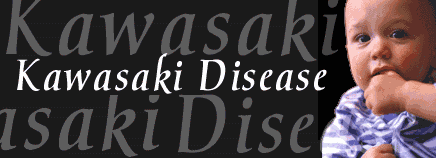
Kawasaki disease is an illness that involves the skin, mouth, and lymph nodes, and most often affects kids under age 5. The cause is unknown, but if the symptoms are recognized early, kids with Kawasaki disease can fully recover within a few days. Untreated, it can lead to serious complications that can affect the heart.
Kawasaki disease is most common among children of Japanese and Korean descent, but can affect all ethnic groups.
Signs and Symptoms
Kawasaki disease can’t be prevented, but usually has telltale symptoms and signs that appear in phases. The first phase, which can last for up to 2 weeks, usually involves a fever that lasts for at least 5 days.
Other symptoms include:
- severe redness in the eyes
- a rash on the stomach, chest, and genitals
- red, dry, cracked lips
- swollen tongue with a white coating and big red bumps (called “strawberry tongue”)
- sore, irritated throat
- swollen palms of the hands and soles of the feet with a purple-red color
- swollen lymph nodes
During the second phase, which usually begins within 2 weeks of when the fever started, the skin on the hands and feet may begin to peel in large pieces. This can even happen in children who have already been treated. A child also may have joint pain, diarrhea, vomiting, or abdominal pain.
If your child shows any of these symptoms, call your doctor.
Complications
Doctors can manage the symptoms of Kawasaki disease if it’s caught early. Most kids will feel better within 2 days of starting treatment. Heart problems usually won’t develop if Kawasaki disease is treated within 10 days of the start of symptoms.
Untreated cases can lead to more serious complications, such as vasculitis, an inflammation of the blood vessels. This can be particularly dangerous because it can affect the coronary arteries, which supply blood to the heart.
Besides the coronary arteries, the heart muscle, lining, valves, and the outer membrane around the heart can become inflamed. Arrhythmias (changes in the normal pattern of the heartbeat) or abnormal functioning of some heart valves also can occur.
Diagnosis
Kawasaki disease can look similar to other common childhood viral and bacterial illnesses. No single test can detect Kawasaki disease, so doctors usually diagnose it by checking the symptoms and ruling out other conditions.
Most kids diagnosed with Kawasaki disease will have a fever lasting 5 or more days and at least four of these symptoms:
- redness in both eyes
- changes around the lips, tongue, or mouth
- changes in the fingers and toes, such as swelling, color change, or peeling
- a rash in the chest, stomach, or genital area
- a large swollen lymph node in the neck
- red, swollen palms of hands and soles of feet
If Kawasaki disease is suspected, the doctor may order tests to monitor heart function (such as an echocardiogram) and might take blood and urine (pee) samples to rule out other conditions, such as scarlet fever, measles, Rocky Mountain spotted fever, juvenile rheumatoid arthritis, or an allergic drug reaction.
Treatment
Treatment should start as soon as possible, ideally within 10 days of when the fever begins. Usually, a child is treated with intravenous (IV) doses of gamma globulin (purified antibodies), an ingredient of blood that helps the body fight infection.
A child also might be given a high dose of aspirin to lower the risk of heart problems. Some kids with Kawasaki disease are put on a low dose of aspirin for a long time to prevent heart problems. It’s very important for these children to get their annual flu shot to help prevent viral illnesses while they are taking the aspirin. This is because there’s a risk of Reye syndrome, a rare but serious illness, in children who take aspirin during a viral illness. Always talk to your doctor before giving any of your kids aspirin.
Most children with Kawasaki disease start to get much better after a single treatment with gamma globulin, though sometimes more doses are needed. Most kids recover completely, but some (especially those who develop heart problems after Kawasaki disease) might need need further testing and treatments with a cardiologist.

